Daifuku
I first encountered daifuku at one of my favorite restaurants in Western Massachusetts, Fresh Side. In their deli case were these cute little white and green pillow-looking desserts, sitting behind a hand-written card that said: Mochi (vegan).
I ordered one and when I bit into it, it was such a surprise. First, the texture! It’s like a dense marshmallow, chewy and soft. Sweet, but not overwhelmingly so. Next, the filling. Beans. Beans? Beans. This particular mochi was fillied with a sweetened red bean paste, also called anko, and I think it was the first time I had ever had sweet beans. And it was really good!
Now, if I understand correctly, mochi is a catch-all term for a sweet dessert made with glutenous rice flour dough. It can be baked, wrapped around ice cream, eaten plain, or filled. Filled mochi, like the ones I’m blogging about today, are called daifuku.
Anko is one of the most common fillings, but many people also use berries. Strawberry filled ones are very popular in the spring, and they’re called ichigo daifuku. Whole raspberries also work, and sometimes people include a white sweetened bean paste (as opposed to red) known as shiroan.
Now what if I told you that I made these in the microwave?
I know!
Really.
I was skeptical, too. The microwave in my house is pretty much reserved for reheating leftovers. When I decided to make these, I was sort of shocked that all the recipes online called for nuking the dough. What’s more, they were pretty unclear about how to tell when you’re dough is ready. Microwaves seem to vary so much in power, 3 minutes in one microwave is very different than 3 minutes in another. But I decided to give it a go, and not only did it work, but it was really, really easy. If you are able to find pre-made red bean paste, you can make this whole recipe with only a microwave and just a few minutes.
So not only do you not need a kitchen for these (hello dorm-living vegans!), they’re also gluten free (hi celiacs!), soy free (hi soy…allergic lovelies!), fast (hi lazy people!), customizable (hi picky people!), and did I mention CUTE? Traditional colors are white, green, and pink, but food coloring isn’t required if it grosses you out. Matcha (green tea powder) is a natural and delicious flavoring that makes the mochi green.
 Now the one thing you absolutely need, no substitutions, is mochiko. It’s glutenous rice flour, and no other flour will work for this. You can find it easily at any asian market.
Now the one thing you absolutely need, no substitutions, is mochiko. It’s glutenous rice flour, and no other flour will work for this. You can find it easily at any asian market.
Also make sure you have some cornstarch or potato starch handy, the dough is very sticky!
Daifuku
Makes 10-12 Filled Cakes
1 Cup Mochiko
1/4 Cup Sugar
2/3 Cup Water
2-3 Drops red or green food coloring, optional
Cornstarch or Potato Starch, for dusting
Filling Ideas
Anko (store bought or recipe below)
Strawberries
Raspberries
Anko
Makes enough for 3-4 batches of daifuku
1 14 oz Can Adzuki Beans
1/2 Cup Water
1 Cup Sugar
1 Tbs Vegetable Oil
1-2 Pinches Salt
Heat water and sugar separately until boiling and sugar is dissolved, turn off heat. Drain and rinse beans.
Add to a pan and mash. Add 1/3 cup of the simple syrup you just made, along with salt and vegetable oil, and mash over medium heat. Beans will thicken and become slightly glossy. Add more syrup if desired. Turn out into a bowl and let cool.
Making the Mochi
Add the mochiko, sugar, water, and food coloring (if using) to a microwave safe bowl. Stir well, making sure there are no lumps. Scrape down the sides of the bowl as best you can with a rubber spatula, otherwise they’ll get all gross when the dough is microwaved.
Cover lightly with plastic wrap and mircowave for 2 minutes. Remove bowl from the microwave and stir VERY well. Dough will be much thicker, but there should still be some raw parts underneath. I like to use a sturdy silicone spatula to mix the dough at this point. Place the dough back in the microwave for 1 more minute.
Open the door and peek–did the dough start sinking as soon as the door opened? If so, the dough was inflating while cooking, which means it’s ready. If not, microwave for 1 more minute and check again. You shouldn’t have to microwave for more than 4 minutes total (2 minutes initial cooking, 2 more additional minutes after mixing).
One the dough deflates when you open the door, remove the dough from the microwave and scrape it out onto a cornstarch-coated cutting board.
Pat the hot dough (be careful! It’s hot!) with cornstarch and flatten it out a little. Cut into 10-12 even pieces. Add 1 tsp of filling to each piece and gently press the edges together to seal.
Here’s the whole process in a little HD video for you to watch! No sound, so don’t worry about turning down the volume if you’re at work. The video starts right after I took the dough out of the mircowave and dumped it onto the cutting board.
Making Daifuku on Vimeo.
The best way to keep these fresh is to individually wrap them in plastic wrap and then refrigerate. If you leave them out, unwrapped, they’ll get dry and tough. Enjoy!
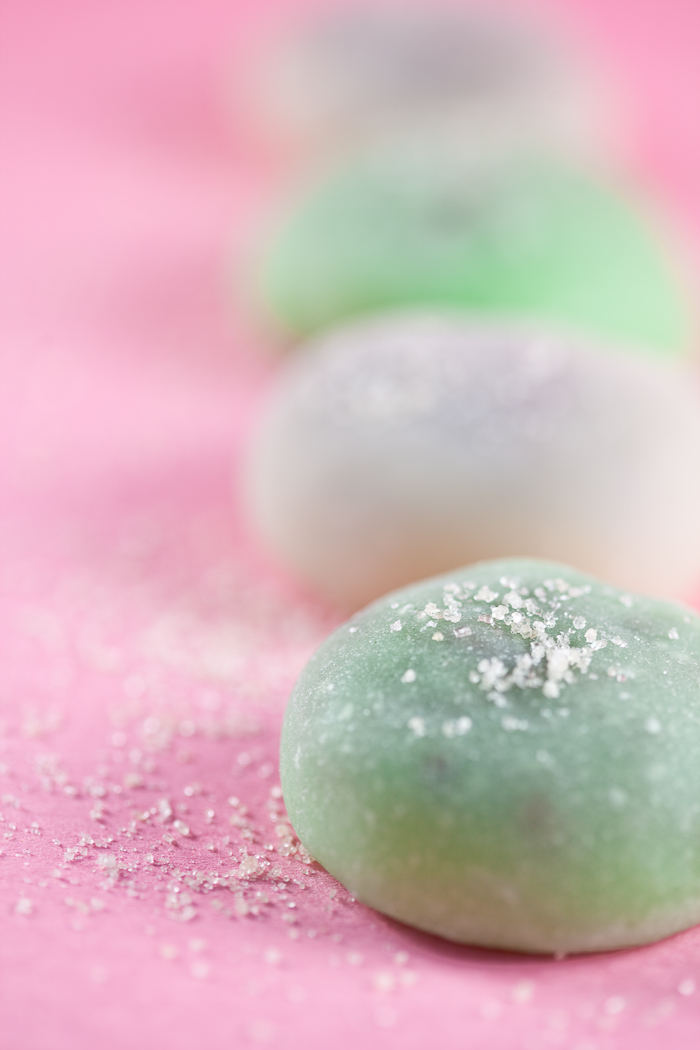
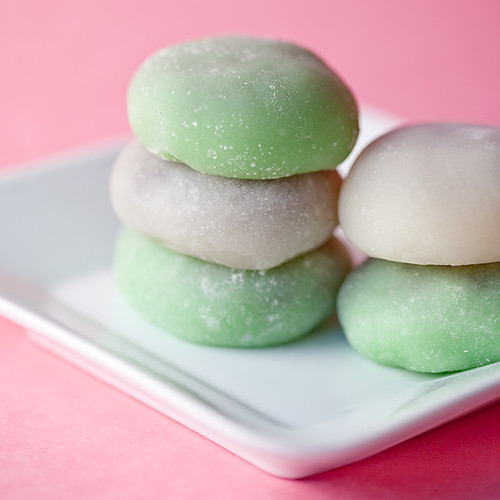
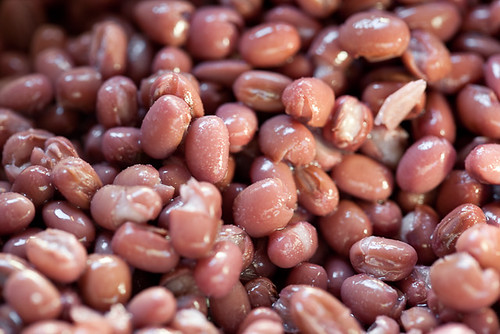
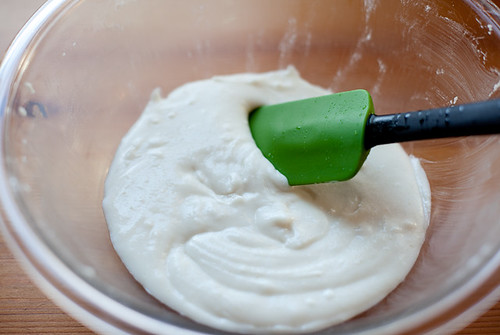
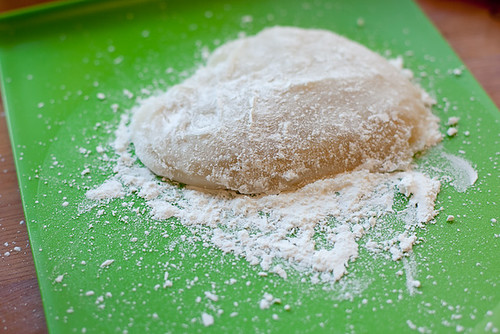
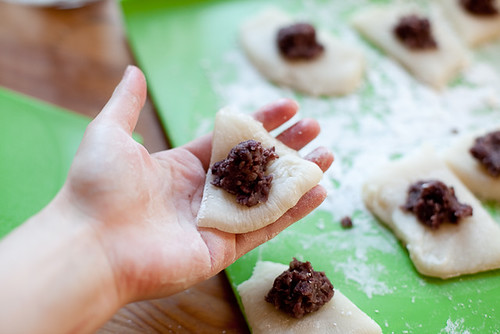
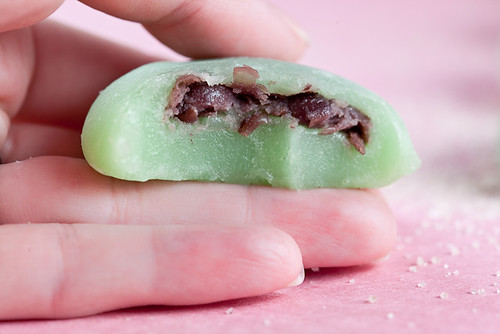
That’s mine, #101. They were really really yummy and I filled them with anko–which I love. I brought some in for the Japanese people at my office who always share their snacks with me. I couldn’t get that perfect round shape you had. I ended up folding mine like little gyoza :)
wiii! i like mochi!!! i like the ones with peanuts in the middle
:D
T___T i made these today and failed 3 times. WAAH. back to trial and error. when you put the mochi dough into the microwave for the 2nd time did you cover it with plastic wrap?
Oh no! Why don’t you shoot me and email and describe what’s going wrong, and we’ll try to figure it out together: lolo @ veganyumyum.com. I’m so sorry you’re having trouble!
I can’t afford you guys . Page after page of printing to get 1 recipe !
I do hope that you will at least try to make it better for us that have to budget our ink and paper . And if you don’t correct this horror , well then you leave me no choice , I will pray every day that you gain 10 pounds of fatty weight for every extra , non essential page that my copier spits out for one of your recipes ……
Thank you …… Ron …..
Mr ron on comment 105, there’s a thing called File>Print>Print Range>Choose the pages you want to print (example:2-6). You can choose by look at Print Preview.
OR
you can just copy and paste the recipe into a Microsoft Word Document and edit it to your liking so you can print it.
It seems that people are still out of date with technology.
Don’t say mean things just because she can’t ‘correct this horror’.
If a page of recipes has a lot of comments, of course you’re going to print out everything. common sense.
Without a Microwave? You boil everything (not rice flour) to a rapid boil and then pouring it over the flour and mix it till it has no lumps. It only takes 2 mins if you use ready boiled water…
Hello, I am a gril from Germany (please sorry for some engl. mistakes ^_^) and I just come accros your recipies. Let me first say how lovely your page is! I’m neither vegan nor vegeterian, but the vegan cooking sonds very interesting (it’s a bit like puzzeling ^_- with food, when you want to avoid special ingrediences) and the fotos looks really appetisingly.
Well, I specially write here at the Daifuku, because I’m very happy to find a recipie for this funny “cake”. When I tried a Daifuku for the first time, I couldn’t image what it is made of.
So thank you!
With kind regards, Jelena
OMG I just got back from Kyoto (I live in California) and there were free daifuku samples all over the place. I’ve never eaten so much mochi in my life. Much of it comes from local sweets shops, and most of it is really fresh… Just had to share!
Do I really have to use cornstarch? Just wondering if there is a substitute for it ;)
Wow! I tried this recipe and it worked very well! Thank you so much! I just wondering if I double the dough quantity I will need to double the time in microwave. I ask you because I’ve separated a small part of the dough to make it pink, but after the microwave it (the pink dough) becomes hard as a rock! What can it be?
I forgot to tell you: the pink dough was just around 1/3 of the whole dough! ^^;
Great instructions, and the photos are beautiful. I can’t wait to try these out!!^^
the timing for microwaving is great! Thank You!
Hi, are you sur it’s edible when those’re just cooked for about 4 mn ?
Hi ! Happen to be here as I search home made graham cracker recipe now ! Wow, I’m really glad because I’m Japanese! and it’s surprising there are so many ppl love Mochi and Daihuku! When I made Shiratama( it’s sort of mochi) for my BF’s daughter few years ago, she couldn’t eat them! lol I thought most of foreigner( well except Asian) didn’t like the texture! Good surprise!
I’m not a vegan but definitly come here again!!Thank you!
Thanks for this recipe! These are hard to find where I live so I’ll definitely be making my own.
One big question, though…
The recipe for making anko calls for water and sugar to be heated separately. What do you do with the water after heated? Do you add it to the heated sugar in order to make the syrup?
I notice some people have said that they’ve had daifuku before but the dough was different, and this might be because you can use one other type of flour for mochi – Shiratamako. I’m not really too sure what the differences are, because I only ever see Mochiko at the korean mart down the street, but eh.
Another thing that’s fun to do is to make the Azuki paste yourself (it’s azuki! ???!). Wash the beans, soak over night, and then start the fun process of boiling and straining and boiling and straining (there’s a recipe over at justhungry.com – search for Tsubu-an). I’ve never tried the store bought kind, but I have tried the commercial daifuku and if you’re like me and you don’t like the tsubu-an to be too sweet you can go ahead and add less sugar if you want.
Anyway! Great idea to put it in the microwave! I’ve been steaming it xD.
Something similar to mochi/daifuku: Dango. Mitarashi dango is my favorite! It has the glutenous rice flour, sweet-salty sauce and it’s very cute. You can even make dango with tofu in it :D.
I had these in japan and they were amazing does anyone know where to find adzuki beans?
looks very good!
I have my first (and only) one from a Chinese Restaurant. I loved it
I soo want to try this myself but I can’t find any rice flour around here :( *Belgium*
wait, you said these were gluten-free, and yet mochiko is glutinous-rice flour. I iz confused.
Ry-Guy, in this case, I’m pretty sure that the “glutinous” in the rice flour just means that it is very sticky, like glue. (GLU[E]tinous)…and, let me tell you, it is indeed very very very sticky!
i heard a lot of people saying that “cheap” mochi (made from the rice flour instead of the traditional way) turns out slightly grainy in texture, rather than the chewy gooshy floofly goodness that i hear so much about.
is that true with this recipe? anybody tried it?
boy, i hope not because i love the idea of cheap, convenient mochi :B
wow, I’m so glad I found this. As a kid we had a Japanese exchange student and her parents sent over a dessert for us. I was the only one of my family that liked it and I’ve been searching for it for many years. It was made of a bean paste and something else that looks like the texture of your mochi made into a roll. and it was sweet but not too sweet and I can’t wait to try this to see if its the same or similar. what makes me excited is that if this is what i’m looking for you just gave a microwavable recipe which would be perfect for me since i’m so lazy :) thanks so much